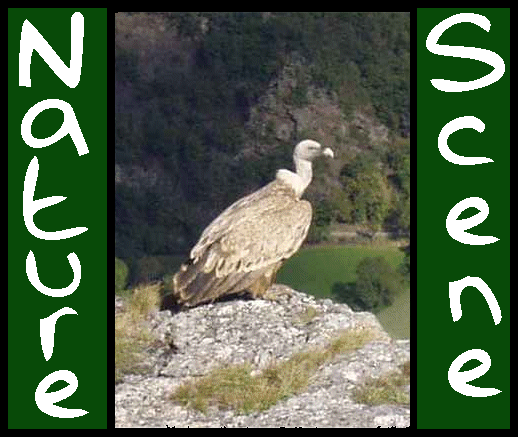
Welcome to NATURESCENE'S
BOTANY ARTICLES of the CÉVENNES
A selection of articles in French and English by David Dickenson of Naturescene, written for the official ALEPE site

|
Throughout the world, trees and grasses are the kings and queens of the plant kingdom.
However, they have failed to conquer the rocky and arid zones.
These habitats require plants to have a few tricks up their sleeves to survive in such hostile conditions.
To take a closer look at this crafty and courageous vegetation, I decided to tackle the steep path from Le Mazel (St. Laurent de Trèves) to the limestone plateau of the Causse Méjean, this sunny weekend. I had for company my wife and dog. The last time that we had puffed up this path, we were 7 years younger, in better physical, if not mental, state, and the dog had been left in the UK. |
|
The village of Le Mazel is situated at 660M altitude, and we often wander along the path that runs
horizontally through the hay meadows, being fairly lazy about life.
At this height, the limestone sits on the schist as a cap, with an abundance of springs. There is therefore a wealth of interesting plants. But this time, we paused just a few moments to admire the blue heads of Meadow Clary (Salvia pratensis) and Tassel Hyacinth (Muscari comosum) (photo 1), the latter named by the French after the shock of blue hair standing on end. |
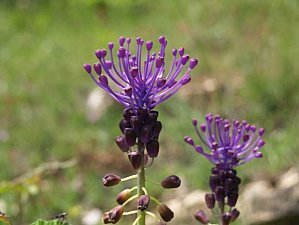
Photo 1 |
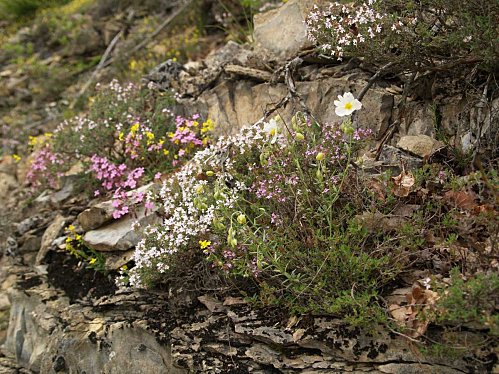
Photo 2 My grandfather would have given his life to have a rockery in his garden like that. |
We then started to climb, and by 720M, the path became gradually steeper and rockier.
We had now reached the dry pasture zone, and in theory, we should have expected to see a wealth of orchids.
We were there 10 days previously, and it was very promising. But the cows, cows the lot of them, had eaten every flower spike. However, they had left untouched the Common Thyme (Thymus vulgaris) (photo 2), in all its matching colours, which made a beautiful display. I am leaving it to you to spot in the photo the Montpellier Soapwort (Saponaria ocymoides), and the Rockroses, such as the white Appenine Rockrose (Helianthemum apenninum) and the yellow Common Rockrose (Helianthemum nummularium). |
| With the dog leading the way (she was searching for a stick in amongst the box shrubs), we continued our climb to 960M; on the way a beautiful patch of the curiously named Bastard balm (Melittis melissophyllum) (Photo 3) struck our eyes. |
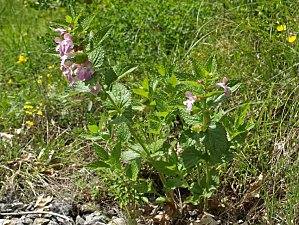
Photo 3 |
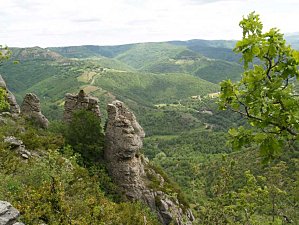
Photo 4 |
The path took a hair-pin bend, and the chaotic dolomitic rocks began to dominate us all around (photo 4),
with the Tarnon valley below just a little speck.
Let the marvels begin. |
|
The Alpine Mezereon (Daphne alpina) (photo 5) is a very attractive bush that is found only
in the most panoramic situations, and here was no exception.
As many as 30 of these plants lined the path for the last 200m, leading up to the causse (a limestone plateau). |
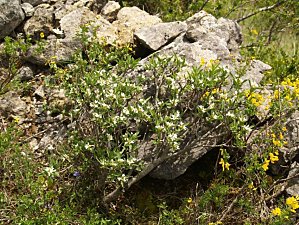
Photo 5 |
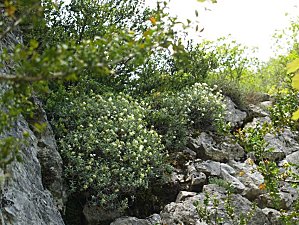
Photo 6 |
The dog was thirsty. Was she hallucinating, with visions of white frothy waterfalls tumbling down
these dry rocky slopes? No, it was cushions of Large-fruited Alison
(Hormathophylla macrocarpa) (photo 6),
forming a tapestry of interlacing branches, protected somewhat by tiny little spines.
This made a pleasing contrast with the lilac of the little Aster of the Causses des Cévennes (Aster alpinus subsp. cebennensis) (photo 7) |
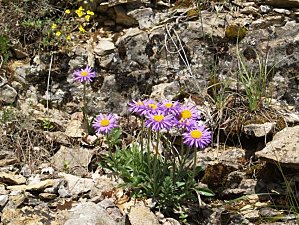
Photo 7 |
| We also spotted some Leucanthemum graminifolium (photo 8). As its Latin name suggests, this is the Grass-leaved Ox-eye Daisy. Lots of rock plants reduce the surface area of their leaves to protect against drought. |
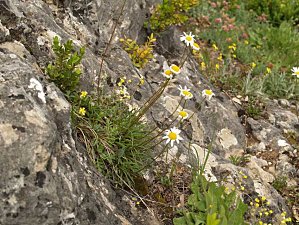
Photo 8 |
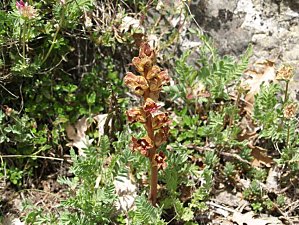
Photo 9 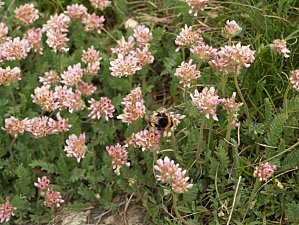
Photo 10 |
The dog sniffed out a group of broomrapes, with a very spicy scent. There are thirteen species
of these parasitic plants in the Cévennes, and it's not easy to tell the difference between them.
However, each species has its preference for its lunch. The idea popped into my head to identify
the plants parasitised around this broomrape, and bingo!
This could be confirmed as the Graceful Broomrape (Orobanche gracilis) (photo 9), with its red throat, which loves to suck on the sap of the Fabaceae family. This time, its food was the unfortunate Mountain Kidney-vetch (Anthyllis montana) (photo 10), which carpeted the path. |
|
Ten minutes later, and we had finally reached 1050M; everything was very flat, and across the
valley we could see streaks of snow on Mont Lozère.
The first stalks of Angel hair (Stipa pennata) (photo 11) had begun to tremble in a warm current of air. We had arrived at the Causse Méjean. There was scarcely a tree to be seen. Other dogs had pinched all the sticks. Upset, Growler faced around, and began her descent. |
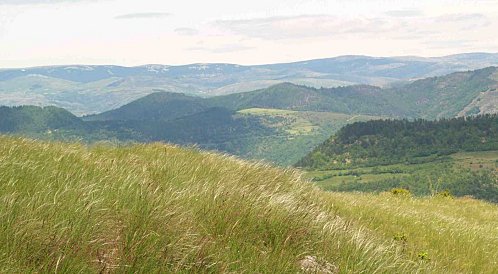
Photo 11 |